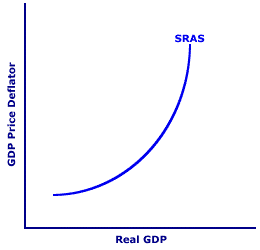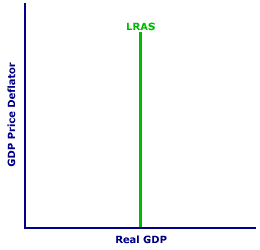
|
|
A: The common notation for the "intercept" term of an equation specified as Y = a + bX. Mathematically, the a-intercept term indicates the value of the Y variable when the value of the X variable is equal to zero. Theoretically, the a-intercept is frequently used to indicate exogenous or independent influences on the Y variable, that is, influences that are independent of the X variable. For example, if Y represents consumption and X represents national income, a measures autonomous consumption expenditures.
Visit the GLOSS*arama
|
|


|

|
                           CAPITAL STOCK, AGGREGATE SUPPLY DETERMINANT: One of several specific aggregate supply determinants assumed constant when the aggregate supply curves (both long run and short run) are constructed, and which shifts the aggregate supply curves when it changes. An increase in the capital stock causes an increase (rightward shift) of both aggregate supply curves. A decrease in the capital stock causes a decrease (leftward shift) of both aggregate supply curves. Other notable aggregate supply determinants include the technology, energy prices, and the wages. Capital stock comes under the resource quantity aggregate supply determinant. Capital stock is the total quantity of capital used in the production of goods and services, including factories, buildings, equipment, tools, and machinery. Without capital, workers obviously have to do ALL production by hand. Capital makes labor productive. More capital makes labor more productive. Changes in the capital stock depend on the difference between business investment expenditures and capital depreciation. If investment in new capital exceeds the depreciation of existing capital, then the capital stock expands. If depreciation exceeds investment, then the capital stock contracts.The size of the capital stock affects the economy's production capabilities. A larger capital stock means greater production capabilities and a small capital stock means lesser production capabilities. In particular, a larger capital stock enables more real production at a given price level, causing an increase in both long-run and short-run aggregate supply. A smaller capital stock means less real production at a given price level, causing a decrease in both long-run and short-run aggregate supply. | Shifting the SRAS Curve |  | Shifting the LRAS Curve | 
|
Consider the pair of aggregate supply curves, both long-run and short run, displayed in the exhibit to the right. The exhibit presents a positively-sloped short-run aggregate supply curve in the top panel and a vertical long-run aggregate supply curve in the bottom panel. Like all aggregate supply curves, these are constructed based on several ceteris paribus aggregate supply determinants, including capital stock. The key question is: What happens to these aggregate supply curves if the capital stock changes?Larger Capital StockSuppose, for example, that investment is particularly intense in a given year, far exceeding the depreciation of existing capital. As such, the business sector adds a sizable quantity of factories, buildings, equipment, tools, and machinery to the existing stock of capital. This increase in the capital stock leads to an increase in aggregate supply, both short run and long run, causing the SRAS and LRAS curves to shift rightward. Note that the increase in the capital stock makes it possible to supply a larger quantity of real production at the same price level, which means an increase in aggregate supply.To see how a larger capital stock affects the aggregate supply curve, click the [More Capital] button. The increase in capital triggers an increase in aggregate supply and a rightward shift of both the short-run and long-run aggregate supply curves. Smaller Capital StockAlternatively, suppose that investment is rather sparse in a given year, falling far short of the depreciation of existing capital. As such, the stock of capital ends up shrinking. This decrease in the capital stock leads to a decrease in aggregate supply, both short run and long run, causing the SRAS and LRAS curves to shift leftward. The increase in the capital stock means less real production is supplied at the same price level, which means a decrease in aggregate supply.To see how a smaller capital stock affects the aggregate supply curve, click the [Less Capital] button. The decrease in capital triggers a decrease in aggregate supply and a leftward shift of both the short-run and long-run aggregate supply curves. What Does It Mean?The importance of the capital stock as an aggregate supply determinant is especially important for the long run expansion of the economy. The capital stock has been a key reason that our modern economy has grown, progressed, and is able to produce trillions of dollars worth of goods and services every year. This capital expansion not only shifts the short-run and long-run aggregate supply curves, it also tends to be subtle and generally overshadowed by business-cycle-inducing shifts of the aggregate demand curve. While the current capital stock can be readily compared with that from a few decades back to note dramatic changes, the year-to-year changes are easy to overlook and can be taken for granted.However, increasing the capital stock is not automatic. Business firms must commit annual investment expenditures to the purchase of new capital over and above the depreciation of existing capital. But such investment is inherently a risky undertaking affected by a number of influences, including interest rates, government policies, technology, inflation, business cycles, political unrest, and a host of others. InvestmentThis is a good place to note the duo role that investment plays in shifting the aggregate demand curve as well as the short-run and long-run aggregate supply curves. Investment is one of the four primary determinants of aggregate demand. In fact, it may very well be THE most important aggregate demand determinant when it comes to analyzing business cycles. An increase in investment expenditures causes an increase in aggregate demand and a decrease causes a decrease in aggregate demand. In fact, investment tends to fluctuate a lot from year to year, falling by 10 percent one year, then rising by 20 percent the next. These relatively large changes in investment contribute enormously to business-cycle contractions and expansions.However, investment also affects the capital stock and thus aggregate supply. At the same time a change in investment shifts the aggregate demand curve, it also affects the capital stock, which causes shifts of the aggregate supply curves. But there is a big qualification. A 10-20 percent change in investment is about 2 percent of aggregate expenditures, which is big enough to trigger a business-cycle instability. This same 10-20 percent change in investment, after netting out depreciation, is likely to generate less than 0.1 percent change in the capital stock. This is hardly noticeable on a year-to-year basis, especially when compared to other aggregate supply determinants like population growth and advancing technology. This is why macroeconomic analysis is generally concerned about the role investment plays on the demand-side of the aggregate market, with less focus on the supply-side. While supply-side changes in capital can be overlooked on a year-to-year basis, ignoring them over longer periods can cause problems. Over the decades, investment has a profound affect on the economy.

Recommended Citation:CAPITAL STOCK, AGGREGATE SUPPLY DETERMINANT, AmosWEB Encyclonomic WEB*pedia, http://www.AmosWEB.com, AmosWEB LLC, 2000-2025. [Accessed: July 3, 2025].
Check Out These Related Terms... | | | | | | | | | | | | |
Or For A Little Background... | | | | | | | | | | | | | | | | |
And For Further Study... | | | | | | | | | | | |
Search Again?
Back to the WEB*pedia
|



|

|
ORANGE REBELOON
[What's This?]
Today, you are likely to spend a great deal of time searching for a specialty store trying to buy either one of those memory foam pillows or a remote controlled train set. Be on the lookout for telephone calls from long-lost relatives.
Your Complete Scope
This isn't me! What am I?
|

|
|
In the Middle Ages, pepper was used for bartering, and it was often more valuable and stable in value than gold.
|

|
|
"Far and away the best prize that life has to offer is the chance to work hard at work worth doing." -- Theodore Roosevelt, 26th US president
|

|
SMSA
Standard Metropolitan Statistical Area
|

|
|
Tell us what you think about AmosWEB. Like what you see? Have suggestions for improvements? Let us know. Click the User Feedback link.
User Feedback
|


|


